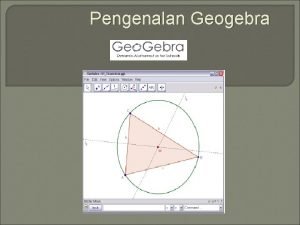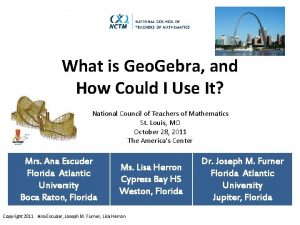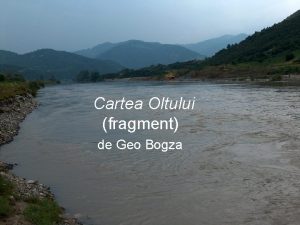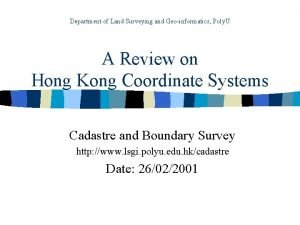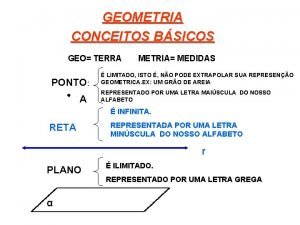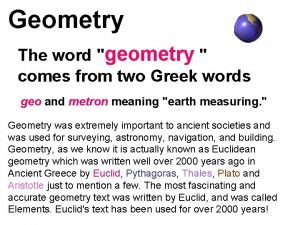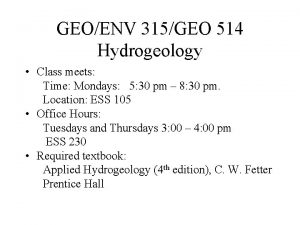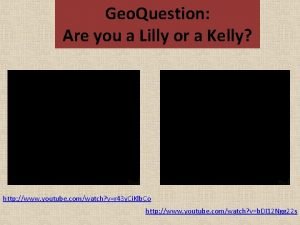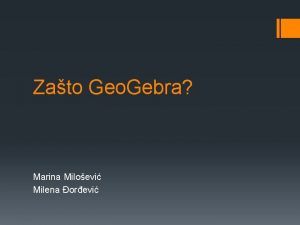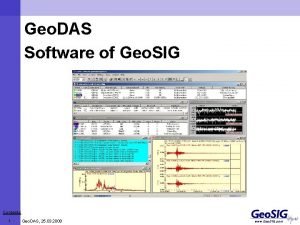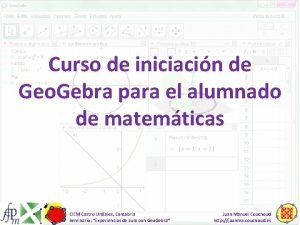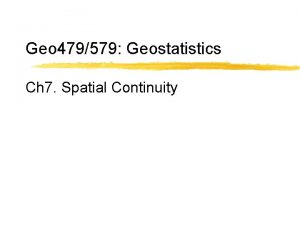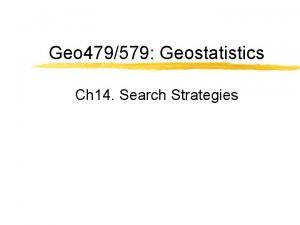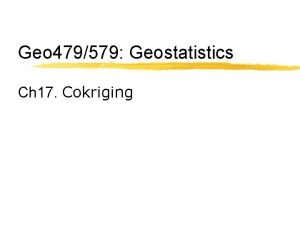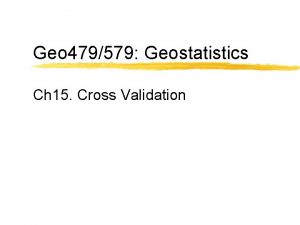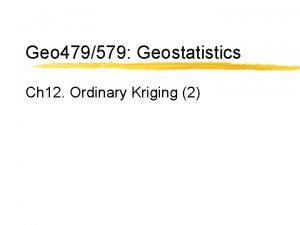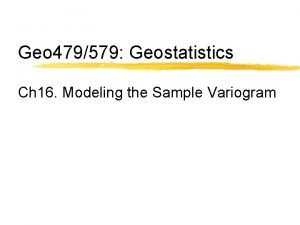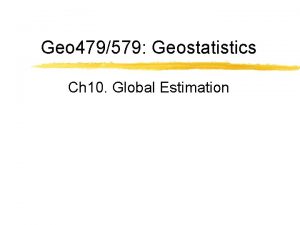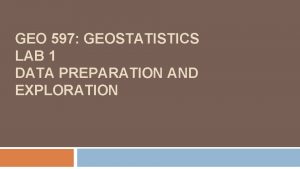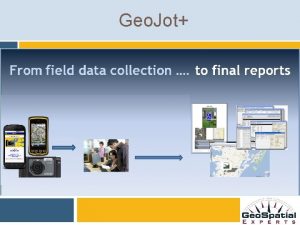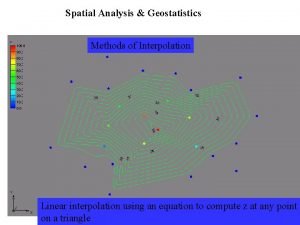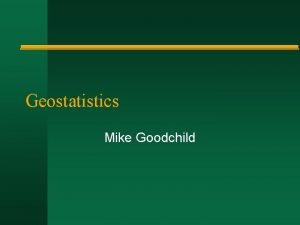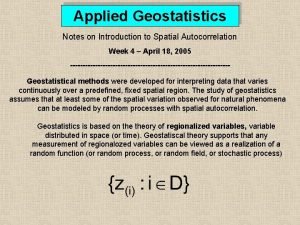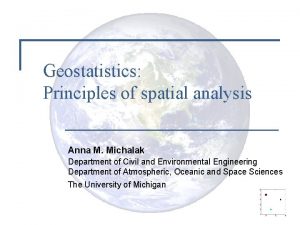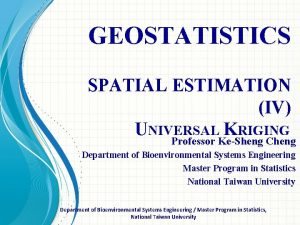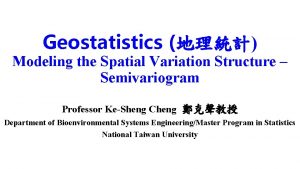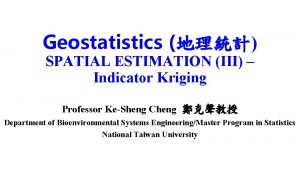Geo 479579 Geostatistics Ch 4 Spatial Description What











































- Slides: 43

Geo 479/579: Geostatistics Ch 4. Spatial Description

What is GIS? ► G: maps ► I: spreadsheets ► S: the system that puts the maps and spreadsheets together


Components in GIS ► Spatial locations ► Attributes ► Topology

Spatial Locations ► Specified with reference to a common coordinate system Geographic coordinate system (lat and long) UTM (Universal Transverse Mercator) State Plane

GIS Data Models ► Vector points lines polygons networks ► Raster grids courtesy: Mary Ruvane, http: //ils. unc. edu/

Difference from Other Statistics § Geostatistics explicitly consider the spatial nature of the data: such as location of extreme values, spatial trend, and degree of spatial continuity § If we rearrange the data points, do the mean and standard deviation change? Do the geostatistical measurements change? § Statistics, geostatistics, spatial statistics

Data Posting § A map on which each data location is plotted, along with its corresponding data value. § Data posting is an important initial step for detecting outliers or errors in the data. (A single high value surrounded by low values are worth rechecking) § Data posting gives an idea of how data are sampled, and it may reveal some trends in the data.


Contour Maps Contour maps show trends and outliers

Symbol Maps § Symbol map use color and other symbols to show values in classes and the order between classes

Indicator Maps They show where values are above or below a threshold. A series of indicator maps can be used to show a phenomenon

Moving Window Statistics § Implication of anomalies in the data. § Summary statistics within a moving window is used to investigate anomalies both in the average value and in the variability within regions (windows)

Moving Window Statistics…

Neighborhood Statistics… Moving windows 3 4 5 0 1 Richness Interspersion 6 8 3 1 5 6 7 5 8 8 6 3 4 0 2 1 5 7 5 8 7 8 3 8 0 5 1


Moving Window Statistics… § The size of the window depends on average spacing between point locations and on the overall dimensions of the study area. § Size of the window should be large enough to obtain reliable statistics, and small enough to capture local details. § Overlapping moving windows can have both worlds. If have to choose, reliable statistics is preferred.

Proportional Effect § Proportional effect refers to the relationship between the local means and the local standard deviations from the moving window calculations. § Four relationships between local average and local variability (Figure 4. 8). - a stable local mean and a stable variability - a varying mean but a stable variability - a stable mean but a varying variability - the local mean and variability change together


Proportional Effect… § The first two cases are preferred because of a low variability in standard deviation. § The next best thing is case (d) because the mean is related to the variability in a predictable fashion. § A scatterplot of mean vs. standard deviation helps detect the trend.

Spatial Autocorrelation § First law of geography: “everything is related to everything else, but near things are more related than distant things” – Waldo Tobler § Also known as spatial dependence

Spatial Autocorrelation… § Spatial Autocorrelation is a correlation of a variable with itself through space. § If there is any systematic pattern in the spatial distribution of a variable, it is said to be spatially autocorrelated. § If nearby or neighboring areas are more alike, this is positive spatial autocorrelation. § Negative autocorrelation describes patterns in which neighboring areas are unlike. § Random patterns exhibit no spatial autocorrelation.


Spatial Autocorrelation… § First order effects relate to the variation in the mean value of the process in space – a global or large scale trend. § Second order effects result from the correlation of a variable in reference to spatial location of the variable – local or small scale effects.

Spatial Autocorrelation… § A spatial process is stationary, if its statistical properties such as mean and variance are independent of absolute location, but dependent on the distance and direction between two locations.

H-Scatterplots § An h-scatterplot shows all possible pairs of data values whose locations are separated by a certain distance h in a particular direction. § The location of the point at is denoted as , and the separation between two points i and j can be denoted as or.


H-Scatterplots… § X-axis is labeled V(t), which refers to the value at a particular location t; Y-axis is labeled V(t+h), which refers to the value a distance and direction h away. § The shape of the cloud of points on an hscatterplot tells us how continuous the data values are over a certain distance in a particular direction.


H-Scatterplots… § If the data values at locations separated by h are very similar then the pairs will plot close to the line x=y, a 45 -degree line passing through the origin. § As the data values become less similar, the cloud of points on the h-scatterplot becomes wider and more diffuse.

H-Scatterplots… § In Figure 4. 12, the similarity between pairs of values decreases as the separation distance increases. § Presence of outliers may considerably influence the summary statistics.

Correlation Functions, Covariance Functions, and Variograms § Similarity between V(t) and V(t+h) (fatness of the cloud of points on an h-scatterplot) can be summarized in several ways. § These include covariance correlation function or correlogram variogram

Correlation Functions, Covariance Functions and Variograms… § The relationship between the covariance of an h-scatterplot and h is called the covariance function, denoted as (Equation 4. 2).

Correlation Functions, Covariance Functions and Variograms… § The relationship between the correlation coefficient of an h-scatterplot and h is called the correlation function or correlogram, often denoted as (Equation 4. 5).

Correlation Functions, Covariance Functions and Variograms… § The variogram, is half the average squared difference between the paired data values (Equation 4. 8).


Cross h-Scatterplots § Instead of paring the value of one variable with the value of the same variable at another location, we can pair values of a different variable at another location. § Plot V value at a particular data location against U value at a separation distance h to the east. Figure 4. 14.

Cross h-Scatterplots § Cross-covariance function (Eq 4. 12) § Cross-correlation function (Eq 4. 15) § Cross-semivariogram (Eq 4. 18)



(4. 8) (4. 9) (4. 10) (4. 11)

(4. 12) (4. 15) (4. 18)

Spatial Continuity § Two data close to each other are more likely to have similar values than two data that are far apart. § Relationship between two variables. § Relationship between the value of one variable and the value of the same variable at nearby locations.
 Geo-spatial.org
Geo-spatial.org Spatial data vs non spatial data
Spatial data vs non spatial data Spatial order?
Spatial order? Geo gebras
Geo gebras Geo gebra
Geo gebra Geo gebra classic
Geo gebra classic Slang definition ap human geography
Slang definition ap human geography Chicago multiple nuclei model
Chicago multiple nuclei model Geo 802
Geo 802 Cartea oltului
Cartea oltului Geo 802
Geo 802 Dispersal ap human geography definition
Dispersal ap human geography definition Hk 1980 grid
Hk 1980 grid Geo
Geo Geo ceccaroli
Geo ceccaroli Geo knowledge hub
Geo knowledge hub Geo fest
Geo fest Figura plana
Figura plana Geo agro
Geo agro Geo
Geo Geo shelter
Geo shelter Greek words with meaning
Greek words with meaning Geo-redundant architecture
Geo-redundant architecture Inconcinnitas sallustio
Inconcinnitas sallustio Geo indigenous alliance
Geo indigenous alliance It is a circular or elliptical anticlinal structure
It is a circular or elliptical anticlinal structure Sql server geo clustering
Sql server geo clustering Canwro
Canwro Geoberaad
Geoberaad Geo 514
Geo 514 Global geo services
Global geo services Geo gebra
Geo gebra Geo watch
Geo watch Geo gebre
Geo gebre Geometrik ortalama nedir
Geometrik ortalama nedir Corageo
Corageo Geo das
Geo das Geohistogram
Geohistogram Manas geo tech india pvt ltd
Manas geo tech india pvt ltd Topographic map definition ap human geography
Topographic map definition ap human geography Geo wize
Geo wize Ravenstein's laws of migration ap human geography
Ravenstein's laws of migration ap human geography Geo
Geo Geo
Geo



